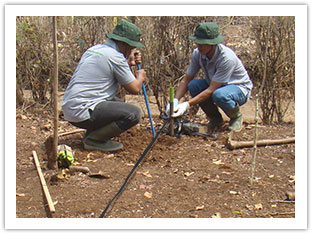.
Teak Closeouts Planting Program

 In late 2013, Teak Closeouts announced a program to plant 1 tree for each item sold online. The program was simple; 1 tree for any item, any size. Even in the case of a large table, 1 tree often yields 2 tables. In the case of folding chairs, 1 tree can yield 50 chairs. In late 2013, Teak Closeouts announced a program to plant 1 tree for each item sold online. The program was simple; 1 tree for any item, any size. Even in the case of a large table, 1 tree often yields 2 tables. In the case of folding chairs, 1 tree can yield 50 chairs.
The design of the program was to provide a BACK-END solution to the many programs that try and track the source of the wood on the FRONT-END. The problem is the front-end programs are often misrepresented or flat out incorrect. The idea of knowing where the wood is from sounds great, but the reality is far from the truth promoted. And in our case, most of the products were produced many years before we arrived to buy them. We've stumbled on inventory sitting as long as 8-years.
We also looked at several replanting programs within Indonesia, but in our opinion, each had a flaw in their system. In the end, we felt the best way to tackle our program was to plant the trees ourselves.
 In mid-2015, we set-out to implement our planting program.The plan was to give the trees free-of-charge to various groups, farmers, suppliers, or anyone of past acquaintance that had land and wanted to plant trees. There is no law that says legal teak must be planted in a plantation. Now, there is a law that requires you to document the cutting of teak trees - and this has changed over the years also fraught with irregularities and red tape. Most red tape in Indonesia is slang for some bribe, roadblock, or confusing mess of legal language that can be interpreted in whatever way the other person decides. In mid-2015, we set-out to implement our planting program.The plan was to give the trees free-of-charge to various groups, farmers, suppliers, or anyone of past acquaintance that had land and wanted to plant trees. There is no law that says legal teak must be planted in a plantation. Now, there is a law that requires you to document the cutting of teak trees - and this has changed over the years also fraught with irregularities and red tape. Most red tape in Indonesia is slang for some bribe, roadblock, or confusing mess of legal language that can be interpreted in whatever way the other person decides.
The reality is a farmer or property owner will take care of their land better than a government employee tasked with the protection of government plantation lands. In addition, the profit from the wood goes directly to the farmer versus a corrupt system of employees and government.
Our 2015 planting which consists of sales from 2014 are divided among 26 property owners ranging from 30-250 trees each.
Our first purchase of teak trees were offered to our employees to use on their land or owned by their family. Of the 26 property owners, 9 are Teak Closeouts employees.

The trees planted are only teak trees. We'd like to plant a few rare slow-growing trees like ulin, but it is hard to get farmers to plant a tree where they will not see a harvest in their lifetime (or several generations).
The pictures here are farmers, landowners, and employees prepping the land for planting. The planting itself will happen at the beginning of the wet season. The logistics of the planting itself is longer than the actual planting. Here they are preparing the land for the planting by digging the holes and filling it with natural nutrients such as manure.
It is our hope that our planting program will be a true carbon-positive program where we return wood back to the earth and oxygen back into the air. In addition, we feel good that the people who benefit from the tree sales are people in need versus fat cats or some system of corruption.

And what does Plantation wood mean anyway? Do you think manufactures go to the "Plantation Store" where all the legal wood is harvested to buy their wood? The entire Plantation scheme is a fraud too. You can't just go to the Plantations and buy wood. In fact, with the ever-dwindling supply of teakwood, the plantations are dividing their supply within a small consortium of large manufactures.
But this page is not to be about the corrupt practices within a third-world.
|
|
|